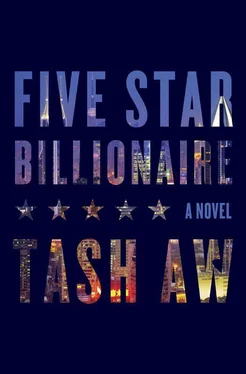Yes, it is clear that Gary has a drinking problem; no one can deny it. Like many young people, he certainly does not react well to alcohol. But is it right for a superstar with so many privileges to behave this way in public, especially when his actions hurt other people? This is a tragic affair, and no matter how many innocent, ordinary people are harmed by his alcohol-fueled madness, the ultimate victim is Gary himself: the fallen angel.
Let us not judge him too harshly — he is a poor young man who should be left to deal with his problems in private , one magazine said, quoting a line from an interview with Vivian Woo, another Malaysian-born Taiwanese starlet who dated Gary for a few months. “His heart is made of gold; it’s just that he has a bad temper and sometimes does not know how to control it,” Vivian said. “That’s why people think he is a disgusting person.” When asked if he was ever violent with her, she replied, “No comment.” The picture they ran with the front-page interview was of Gary in the bar on the Bund in Shanghai, his beautiful profile revealing a man defeated by his weaknesses. How could such an innocent face be capable of such dark hatred? This is the question the papers ask time and time again — a question that fascinates the general public, even people who are not interested in pop music.
It did not take long for the gutter press to find its way to Gary’s hometown in the north of Malaysia. Low-cost flights are so abundant nowadays that it is easy to send a small army of reporters from Hong Kong or Shanghai all the way to rural Malaysia. Within a week there were numerous stories of Gary’s troubled adolescence, all the fights he got into when he was a teenager, before he won his first talent contest. Various newspapers bore “testimonies” of local youths who supplied snippets of information that proved Gary’s waywardness even from a young age, his propensity for physical violence. “One time, ah, I call him a bad name. Just joking only, what! That time, we all about thirteen year old,” said one young man, a truck driver for a local cement company. “Suddenly, ah, he just take a brick and whack my face, ha, like that.” In the photo, the man points to his jawbone, his face creased in pain as if the act had been committed yesterday. From the cheap streaky yellow highlights in his hair and the gold bracelet on his wrist, it is obvious to most people that he is a small-town gangster, like many of the other people interviewed in connection with Gary’s scandalous life, but this fact is not relevant to the sensational story at hand. Readers do not want to know about those incidental lives: The truck driver drives his trucks; the ice-cream seller sells ice cream. People are interested only in those lives that are ruined. For when something is ruined, you can use the rubble to reconstruct something completely different, something that never really existed — this is something that Gary is beginning to realize.
As he sits in his hotel room, looking at the newspapers spread out across the floor, Gary reads about himself with all the detached haziness of a dream: The reassembled fragments of his life add up to someone who is definitely him but also not him — a half-imagined, half-genuine Gary, whom he has problems recognizing. It is exactly how he feels when he sees himself in his music videos. He remembers hitting the truck driver twelve, thirteen years ago, when they were both still boys. With a brick, it is true — though it was only a fragment of a brick, so small that he could hold it concealed in his fist. And while Gary did make contact with the other boy’s face, the boy was able to dodge the full impact of Gary’s swing and was therefore not seriously hurt. He had lain on the ground for a long time after Gary hit him, the shock of Gary’s attack wounding him far more than the actual blow. It was the first real fight that Gary got into, and it emboldened him, made him feel strong. Gary remembers standing over his adversary, the other boy’s friends huddled in a semicircle around their fallen comrade. Some of their faces appear in the newspapers; Gary recognizes them — older, bonier, the harshness of their faces accentuated by age, talking about how Gary was always armed with dangerous weapons, an iron bar, a penknife. He can remember, too, their endless taunts — the bad words thirteen-year-olds call one another: bapok, chibai, kaneenabu —can remember crouching in a fetal ball on the ground as they kicked and punched him; can remember the moment he saw the piece of broken brick and picked it up in his hand, swinging his arm as fast as he could; can remember the gang leader’s open face, the confusion and shock; can remember the wild sensation of adrenaline pumping into his forehead, the soft crunch of the boy’s jawbone, the crazy exhilaration as the boy dropped to the floor, the knowledge that he could — and would — do this many times again in his life, that with every punch or kick he threw, he would feel this doped-up rush once more. Above all, he can remember the sad emptiness as the excitement later drained away from his veins, leaving him to realize that even his newfound source of ecstasy would truly never satisfy him, that it would always lift him to great heights before letting him plummet once more.
Of course, the newspapers managed to track down his foster father — a wizened, leather-skinned man standing behind the metal-grille door of a small, badly kept single-story link house in a bad part of Kota Bharu. The photographs show the tiny cement yard in front of the house, the rusting, disassembled handlebars of an old motorbike, a pile of deflated tires, an empty cage that might once have contained a few chickens or a medium-size dog, and a clay pot full of weeds. The stories describe how, from behind the bars of the door, he shouts obscenities in Hokkien at every visitor. He is not used to company; he does not welcome strangers. One reporter recounts being physically chased from the house by this old grandfather wielding a broomstick. Now we know where Gary gets his tendency for confrontation! the journalist mocks. It is a hilarious image: a frail pensioner, barely five feet tall, chasing a young fashionable journalist from his shabby home, little more than a shack, wielding a broomstick. It makes readers laugh — this whole affair is not very serious at all. That’s what these provincial people are like; their lives are hard but at the same time (let’s admit it) slightly comic. The harshness of their meager existence makes them act in strange ways. You can’t really blame Gary for behaving erratically, for he can never escape his roots. He is a superstar who drank $1,000 bottles of champagne at the age of twenty-two, but at heart he is still a small-town ruffian — a miscreant who will never be able to change. His whole life from start to present has been ridiculous.
Gary tries to remember if this little old man ever used a broomstick to hit him: rattan cane, broken table leg, plastic bucket, worn canvas boot, strip of car tire consigned to scrap — and, yes, a stump of a broomstick. He would use any banal domestic object that happened to be in his field of vision at the time of one of his tempers, but he never used his hands or fists, as if he was afraid of making contact with Gary directly, as if even a sharp blow with the back of his hand might involve a split-second touch of Gary’s skin. Gary had just turned eleven when his mother died and he came to live with this man, the skinny hunchback cousin of hers, a man who could barely support himself in retirement, never mind a hungry, growing child. At the age of sixty-six, he was still working part-time in a scrap yard to support himself, so it was no surprise that he did not take well to the arrival of a child in need of looking after. It was no surprise, too, that he beat Gary regularly, for he was already an alcoholic long before Gary arrived.
Читать дальше
Конец ознакомительного отрывка
Купить книгу


![Scott O’Hara - Five-Star Fugitive [= Border Town Girl]](/books/432138/scott-o-hara-five-thumb.webp)









